26 Jun Cape Horn — Home, but no Earring
Cape Horn, jutting like a rhinoceros horn from the very bottom of South America, is as aptly named a piece of real estate you’re likely to find. At least that’s what I’d always supposed.
For hundreds of years, rounding the Horn meant taking a wooden ship into the Screaming Fifties, maybe the roughest waters on the planet. Sailors who made the journey advertised the fact by wearing a gold hoop-earring in the landward ear. And that wasn’t all they got to do. They were entitled to sit in the presence of kings and, at meals, eat with one foot on the table.
Not that I would ever want to something so gaudy as wear a hoop earring. I’ve known too many ladies who’ve gotten their hoops snagged on things to try my luck with that. And I was pretty sure I’d ever be ushered into the presence of a king. But propping a foot on the table had been a private ambition since Mother caught me resting my elbows next to my plate. To live the dream, all I had to do was sail a boat around Cape Horn? That didn’t sound so hard to arrange. On paper.
On paper you can learn a lot of things. Like geography. Maps are on paper, and it turns out that the horn-shaped part of South America is actually the pointy end of Tierra del Fuego. And, being an island, Tierra del Fuego isn’t even part of South America. It does have a Cape Horn, but it’s the False Cape Horn. The real Cape Horn is on Isla Hornos. Horn Island.
Remote as Horn Island may be, a steamer from Ushuaia, the southernmost city in Argentina, passes it on the way to Punta Arenas, the southernmost city in Chile. And, if the captain is in a good mood and the weather is smiling, passengers can launch out in a rubber boat and visit the place. Sizewise, Horn Island isn’t much of an island and, I calculated, with honeyed words and an appropriate contribution to the ship’s fund, the crewman in charge of the rubber boat might let me take the tiller for a quick jaunt around the island.
I think somebody may have tried this before because it turns out there are rules. You can’t just swing around Horn Island in a rubber boat and get an earring out of the deal. You have to do it in a sailing ship. And you have to sail the sailing ship, which means standing watch for a minimum of fifty days before getting to Horn Island.
By steamer, it only took Peg and me a couple of days to get there. The sky was blue and the water, if not glassy, was smoother than some lakes I’ve canoed on.
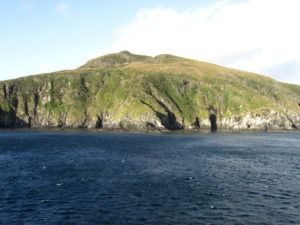
The captain smiled and Peg, and I, and the other passengers piled into rubber boats and headed for the base of the cliff that ringed the island,
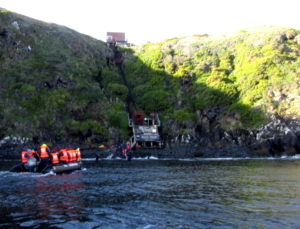
clambered onto a rocky beach
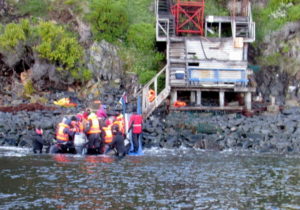
clambered onto a rocky beach
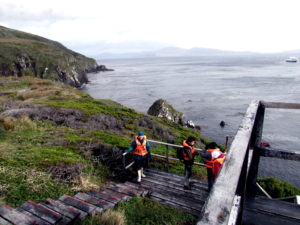
as quickly as our lungs would allow. We wanted to be well ashore before the weather turned and the captain blasted the whistle ordering us back to the ship. Not that the weather looked like it would turn, but we’d heard stories.
At the top of the steps was a sign
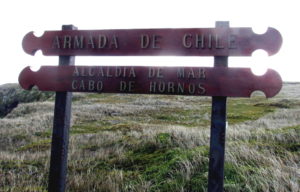
CABO DE HORNOS
which made it official. We’d arrived.
A lighthouse stood in the distance, complete with a lighthouse keeper who didn’t get many visitors and, we were told, had been hoping we’d drop by. Being welcomed to Horn Island by a lighthouse keeper sounded like just the ticket, but first we followed the wooden walkway across the grassy plateau
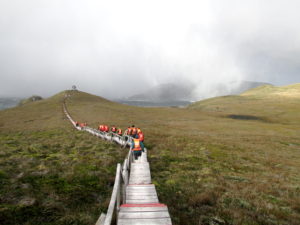
to a little knoll with a steel cutout of an albatross that served as a monument
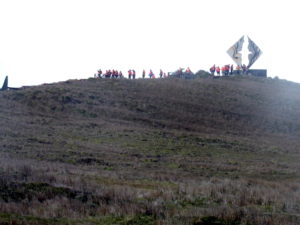
to the eight-hundred ships and ten-thousand-or-so sailors who’d set out around the Horn, imagining the weather wasn’t going to turn.
The monument is austere and bleak and, to my mind, just right for the purpose. Peggy and I were mugging for pictures when the wind picked up and clouds whirled and hail clattered against our jackets, the Fifties began to scream, the ship blasted its whistle and we had to scurry back onboard.
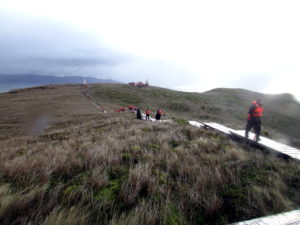
By then, the ocean didn’t seem nearly so lake-like. It was no wonder the lighthouse keeper didn’t get many visitors.
Somewhere along in there I started wondering about that horn business. There wasn’t anything on the island that reminded me of horns. Just rocks and windswept grass. But the sign had been pretty clear.
CABO DE HORNOS
People who know things will tell you Spanish is a poetic language. Maybe, I thought, “hornos” carries overlays of meanings. Maybe, if your Spanish is good enough, you can hear suggestions of danger in the word, and hardship. Of courage and perseverance. Of the romance of brave men and crashing waves and howling winds at the bottom of the world. So, I looked it up.
I was right. Hornos does have another meaning. In fact, the other meaning is the only meaning it has, a meaning that seems never to have occurred to generations of English-speaking sailors. Or, if it did, they decided to go with “Horn” and left it at that. What hornos means is “ovens.”
Ovens? For a place with a year-round average temperature of 41 degrees?
All those people died, and all those ships were lost trying to make their way around the Cape of Ovens?
Generations of Spanish sailors came back to Sevilla with tales of rounding the Ovens? What did that entitle them to do? Wear biscuits on their heads?
Multicultural as I’m known to be, I’m with the tough old English seadogs on this one. It’s the Horn, and don’t let anybody tell you different.
Multicultural as I’m known to be, I’m with the tough old English seadogs on this one. It’s the Horn, and don’t let anybody tell you different.


No Comments